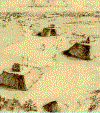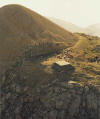|
Gympie
The town of Gympie, at Tin Can Bay, north of Brisbane,
Queensland, is the unlikely site of a pyramid complex. The first
Europeans to come into the area in the 1830's learned of them
from the now extinct Kabi speaking people of Gympie, known then
as the Dhamuri. According to the Aboriginals, brown skinned,
blue eyed, blond haired beings with Dolphin pendants came from
the star Orion and built the pyramids and temple sites, but
water came in and destroyed it all long ago. The ruins were
taboo to them.
Settlers took the stones of the pyramids and other buildings and
used them as foundation stones for the main street of Gympie and
the construction of buildings, including the local church, which
still stands. There were stone statues like the Easter Island
statues and also animal statues. These have since been destroyed
or are hidden, but photos and sketches of them remain from the
first white man to come into the area. Even the tunnels under
Gympie were dynamited.
All but one of the Pyramids were bulldozed into the ocean by the
army in the 1950's and the lone survivor remains on private land
with a strict "no trespassing policy". The Pyramid is 100 foot
high and designed with a series of terraces up to 4 feet tall
and eight feet wide. The army sealed the entrance in the 1930's
after investigating reports of cattle wandering into the pyramid,
when an opening was still accessible, and never coming out. No
reports or findings are available. In recent years, according to
locals, the owner has attempted to destroy the pyramid in the
hopes of discouraging visitors to the site. Artifacts have
survived including the 'Gympie Ape', which was dug up in 1966
and is thought to be a statue of the Egyptian God Horus, who was
often portrayed as an ape, and another resembling Ganesha from
Indian mythology.
|

Artist's
Rendering Gympie Petroglyph |

The Gympie Ape |
Central Coast
A pyramid structure, at least twice the height and dimensions of
the Gympie example, has been found near the NSW Central Coast.
New Guinea
Five pyramids, identical to the Gympie Structure, have been
found in northeastern New Guinea
Magnetic Island
There is a pyramid on Magnetic Island and a sphinx.
 |























